


This representation includes the well-known series of character dances in the second act of the ballet, but also the use of French fashion from the revolutionary era to costume the party guests, the mechanical dolls, the toy soldiers, and even Prince Nutcracker. Despite the lively scholarly debate on the place of The Sleeping Beauty (1890) in the political and cultural history of the Franco-Russian alliance in the 1890s, the representation of international relations in the first production of The Nutcracker (1892) has so far received little attention.


 0 kommentar(er)
0 kommentar(er)
